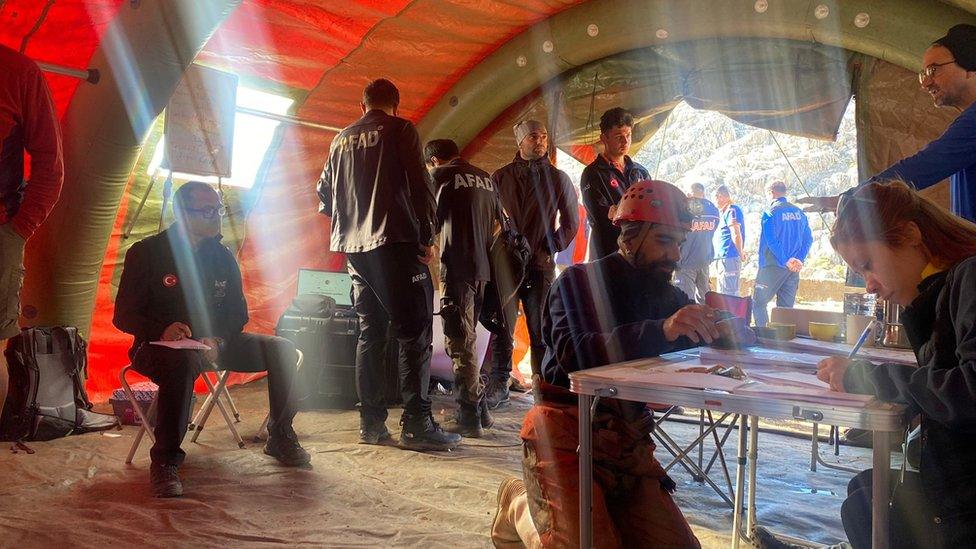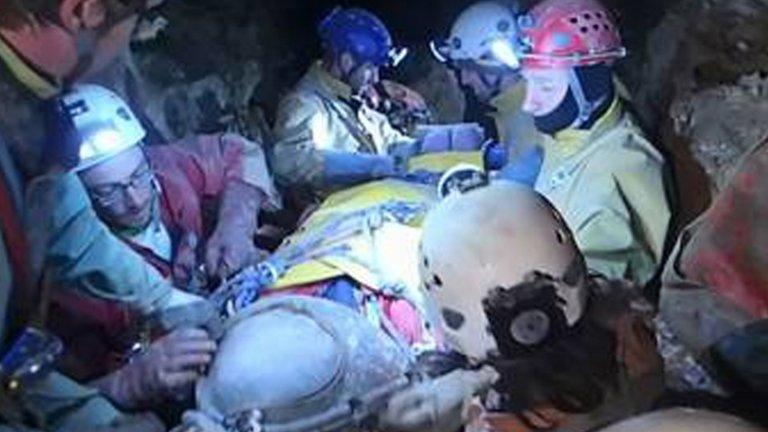Mark Dickey: Huge rescue mission for US man deep in Turkey cave
- Published
Mark Dickey: "I’m not healed on the inside yet so I’m going to need a lot of help to get out of here"
A massive rescue operation has been launched in Turkey after an American man became trapped in the country's third deepest cave complex.
About 150 workers have been working to rescue Mark Dickey, 40, since he became trapped in the Morca Cave on Saturday.
He was co-leading a team to map a new passage in the cave when he began to suffer from gastrointestinal bleeding.
The Turkish Caving Federation said the operation was "complex" as he was stuck at a depth of 1,120m (3,675ft).
Six units of blood were delivered to Mr Dickey, and his condition had stabilised by Thursday lunchtime, the group, which is helping to co-ordinate the rescue, added.
His bleeding had stopped and he was able to walk unsupported, however he will still need a stretcher to be removed from the cave, the federation said in a statement.
"The operation is logistically and technically one of the largest cave rescues in the world," it said. "A long and challenging rescue operation is initiated to carry Mark out on a stretcher."
On Thursday evening, in a video message from inside the cave, Mr Dickey thanked the people attempting to rescue him.
"I do know that the quick response of the Turkish government to get the medical supplies that I need, in my opinion, saved my life. I was very close to the edge," he said.
He added that while he was alert and able to communicate, he had not "healed on the inside" and will need a lot of help to make it out of the cave.
Mr Dickey's friend and fellow caving enthusiast Carl Heitmeyer earlier told the BBC his friend had "stopped vomiting and for the first time in days has even ate a little."
But Dr Yaman Ozakin, a spokesman for the Turkish Caving Federation who is involved in the rescue operation, predicted that the rescue operation could take many more days, and its speed would depend on Mr Dickey's condition.
"The time it will take to evacuate Mark out of the cave depends on whether or not Mark will be in a condition to ascend in the cave without a stretcher," he told the BBC.
If Mr Dickey was able to climb without the help of a stretcher, it could still take up to a week, he said.
"If he has to be carried in a stretcher. It will most likely take 10-15 days, maybe more. The cave has narrow passages that need to be widened for a stretcher," they added.
He also confirmed it was the Disaster and Emergency Management Presidency government agency leading the rescue, after it was earlier reported to be the army.
A number of rescue workers from several other countries, including Croatia and Hungary, have flown to Turkey to assist in the rescue.
Mr Heitmeyer said there was hope rescuers would be able to get him out sooner, but warned any action to free Mr Dickey from the cave would be extremely difficult.
"This rescue will require many rigging teams, passage modification teams [to allow the stretcher to pass through] and also round-the-clock medical care," he said.
He said the Turkish military had managed to establish a communications line with Mr Dickey, and a base camp had been established around 700m (2,296ft) from the cave entrance.
Mr Dickey's fiancée, Jessica Van Ord, was also part of the expedition. She had remained with him while he was unwell, but began climbing out of the cave when his condition improved and is expected to surface late on Thursday, Mr Heitmeyere said.

Mark Dickey, who hails from New Jersey, is said to be a hardened caver with over 20 years experience.
He has been an instructor with the US National Cave Rescue Commission for 10 years, teaching a variety of cave rescue classes. He is also listed as the body's International Exchange Program Coordinator on its website.
He had been co-leading the expedition to the Morca Cave in a remote part of southern Turkey since the end of August, according to the Hungarian Cave Rescue Service, who have been assisting with the operation.
The cave is extremely deep and Mr Heitmeyer told the BBC that it can take "an experienced caver who knows the cave well" about eight hours to go from the entrance to the base camp that Mr Dickey is trapped at.
"It can take up to 15 hours to get there for someone not familiar with the cave," he added, noting that rescue teams will have to deal with wet conditions and temperatures as low as 4C-6C.
Cave rescues at depths of more than 1,000m are relatively uncommon.
In 2014 a man was evacuated from a depth of 1,148m (3,766 ft) at the Riesending cave in Bavaria, Germany. Some 728 people were involved in the operation, which took 11 days.
Related topics
- Published19 June 2014
